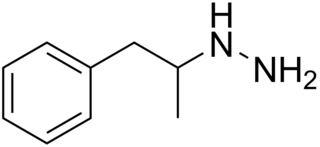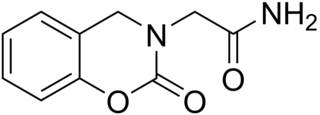
Monoamine oxidase inhibitors (MAOIs) are a class of drugs that inhibit the activity of one or both monoamine oxidase enzymes: monoamine oxidase A (MAO-A) and monoamine oxidase B (MAO-B). They are best known as effective antidepressants, especially for treatment-resistant depression and atypical depression. They are also used to treat panic disorder, social anxiety disorder, Parkinson's disease, and several other disorders.

Tranylcypromine, sold under the brand name Parnate among others, is a monoamine oxidase inhibitor (MAOI). More specifically, tranylcypromine acts as nonselective and irreversible inhibitor of the enzyme monoamine oxidase (MAO). It is used as an antidepressant and anxiolytic agent in the clinical treatment of mood and anxiety disorders, respectively.

Isocarboxazid is a non-selective, irreversible monoamine oxidase inhibitor (MAOI) of the hydrazine class used as an antidepressant. Along with phenelzine and tranylcypromine, it is one of only three classical MAOIs still available for clinical use in the treatment of psychiatric disorders in the United States, though it is not as commonly employed in comparison to the others.

Moclobemide, sold under the brand names Amira, Aurorix, Clobemix, Depnil and Manerix among others, is a reversible inhibitor of monoamine oxidase A (RIMA) drug primarily used to treat depression and social anxiety. It is not approved for use in the United States, but is approved in other Western countries such as Canada, the UK and Australia. It is produced by affiliates of the Hoffmann–La Roche pharmaceutical company. Initially, Aurorix was also marketed by Roche in South Africa, but was withdrawn after its patent rights expired and Cipla Medpro's Depnil and Pharma Dynamic's Clorix became available at half the cost.

Brofaromine is a reversible inhibitor of monoamine oxidase A (RIMA) discovered by Ciba-Geigy. The compound was primarily researched in the treatment of depression and anxiety but its development was dropped before it was brought to market.

Iproclozide is an irreversible and selective monoamine oxidase inhibitor (MAOI) of the hydrazine chemical class that was used as an antidepressant, but has since been discontinued. It has been known to cause fulminant hepatitis and there have been at least three reported fatalities due to administration of the drug.

Toloxatone (Humoryl) is an antidepressant launched in 1984 in France by Sanofi Aventis for the treatment of depression. It was discontinued in 2002. It acts as a selective reversible inhibitor of MAO-A (RIMA).

Minaprine is a monoamine oxidase inhibitor antidepressant drug that was used in France for the treatment of depression until it was withdrawn from the market in 1996 because it caused convulsions.
Pirlindole is mainly a reversible inhibitor of monoamine oxidase A (RIMA) and secondly a SNRI which was developed and is used in Russia as an antidepressant. It is structurally and pharmacologically related to metralindole.

Bifemelane (INN), or bifemelane hydrochloride (JAN), also known as 4-(O-benzylphenoxy)-N-methylbutylamine, is an antidepressant and cerebral activator that is widely used in the treatment of cerebral infarction patients with depressive symptoms in Japan, and in the treatment of senile dementia as well. It also appears to be useful in the treatment of glaucoma. Bifemelane acts as a monoamine oxidase inhibitor (MAOI) of both isoenzymes, with competitive (reversible) inhibition of MAO-A and non-competitive (irreversible) inhibition of MAO-B, and also acts (weakly) as a norepinephrine reuptake inhibitor. The drug has nootropic, neuroprotective, and antidepressant-like effects in animal models, and appears to enhance the cholinergic system in the brain.

Pheniprazine is an irreversible and nonselective monoamine oxidase inhibitor (MAOI) of the hydrazine chemical class that was used as an antidepressant in the 1960s. It was also used in the treatment of angina pectoris and schizophrenia. Pheniprazine has been largely discontinued due to toxicity concerns such as jaundice, amblyopia, and optic neuritis.

Mebanazine is a monoamine oxidase inhibitor (MAOI) of the hydrazine chemical class that was previously used as an antidepressant in the 1960s, but has since been withdrawn due to hepatotoxicity.

Metfendrazine, also known as methphendrazine, is an irreversible and nonselective monoamine oxidase inhibitor (MAOI) of the hydrazine chemical class. It was investigated as an antidepressant, but was never marketed.

Phenoxypropazine is an irreversible and non-selective monoamine oxidase inhibitor (MAOI) of the hydrazine family. It was introduced as an antidepressant in 1961, but was subsequently withdrawn in 1966 due to hepatotoxicity concerns.

Echinopsidine (Adepren) is an antidepressant that was under development in Bulgaria for the treatment of depression. It increases serotonin, norepinephrine, and dopamine levels in the brain and is believed to act as a monoamine oxidase inhibitor (MAOI). Echinopsidine is found naturally in Echinops echinatus along with the related alkaloids echinopsine and echinozolinone.

Caroxazone is an antidepressant which was formerly used for the treatment of depression but is now no longer marketed. It acts as a reversible monoamine oxidase inhibitor (RIMA) of both MAO-A and MAO-B subtypes, with five-fold preference for the latter.

Almoxatone (MD-780,236) is a selective and reversible inhibitor of MAO-B. It was patented as an antidepressant and antiparkinsonian agent but was never marketed.
Tetrindole was a drug candidate that functions by reversibly inhibiting monoamine oxidase A; it was first synthesized in Moscow in the early 1990s. Tetrindole is similar in its chemical structure to pirlindole (Pyrazidol), and metralindole.

Eprobemide (INN) is a pharmaceutical drug that was used as an antidepressant in Russia. It is a non-competitive reversible inhibitor of monoamine oxidase A that exhibits selective action on serotonin deamination. Eprobemide differs from moclobemide only in the linker that connects the morpholine fragment with the chlorobenzamide — moclobemide has two carbon atoms while eprobemide has three. Its registration was cancelled on December 30, 2003.

Acetryptine (INN), also known as 5-acetyltryptamine (5-AT), is a drug described as an antihypertensive agent which was never marketed. Structurally, acetryptine is a substituted tryptamine, and is closely related to other substituted tryptamines like serotonin (5-hydroxytryptamine). It was developed in the early 1960s. The binding of acetryptine to serotonin receptors does not seem to have been well-investigated, although it was assessed at the 5-HT1A and 5-HT1D receptors and found to bind to them with high affinity. The drug may also act as a monoamine oxidase inhibitor (MAOI); specifically, as an inhibitor of MAO-A.


















